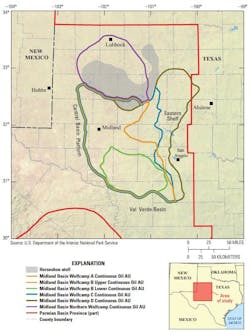USGS: Permian’s Wolfcamp shale contains 20 billion bbl of oil
The Wolfcamp shale in the Midland basin portion of Texas’s Permian basin contains an estimated mean of 20 billion bbl of oil, 16 tcf of associated natural gas, and 1.6 billion bbl of NGLs, according to an assessment by the US Geological Survey.
The estimate—which is for continuous unconventional oil and consists of undiscovered, technically recoverable resources—is nearly three times that of the 2013 USGS Bakken-Three Forks resource assessment, making this the largest estimated continuous oil accumulation that USGS has assessed in the US to date (OGJ, Jan. 6, 2014, p. 48).
“The fact that this is the largest assessment of continuous oil we have ever done just goes to show that, even in areas that have produced billions of barrels of oil, there is still the potential to find billions more,” commented Walter Guidroz, program coordinator for the USGS energy resources program.
Although the USGS has assessed oil and gas resources in the Permian, this is the first assessment of continuous resources in the Wolfcamp. Since the 1980s, the Midland Wolfcamp has been part of the “Wolfberry” play that encompasses Mississippian, Pennsylvanian, and Lower Permian reservoirs. Oil has been produced using traditional vertical well technology.
However, more recently, US exploration and production firms have been using horizontal drilling and hydraulic fracturing, and more than 3,000 horizontal wells have been drilled and completed in the Midland Wolfcamp section.
The Wolfcamp is also present in the Delaware basin portion of the Permian, but was not included in this assessment.
Firms active in the Wolfcamp include Pioneer Natural Resources Co., WPX Energy Inc., Devon Energy Corp., and Diamondback Energy Inc., each of which has reported recent or planned increases in drilling activity there (OGJ Online, Nov. 4, 2016).

